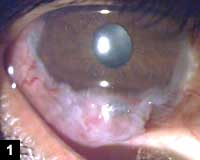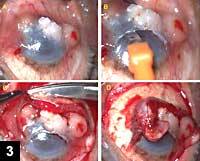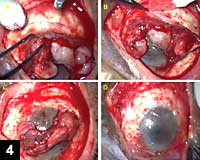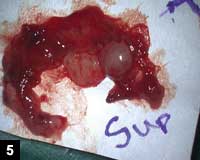Ocular surface squamous neoplasia offers physicians unique challenges
The term ocular surface squamous neoplasia, or OSSN, refers to dysplasias, carcinoma in situ and squamous cell carcinoma of the ocular surface epithelium, conjunctiva and cornea (Figure 1).
Squamous cell carcinoma is the most common conjunctival malignancy in the United States. The conjunctiva and the ocular surface are constantly exposed to sunlight, which is a predisposing factor for developing carcinomas of the ocular surface epithelium. Although squamous cell carcinoma of the conjunctiva is most common in Caucasians, populations living closer to the equator present at a younger age than those living farther away. Other known risk factors that predispose to developing OSSN include exposure to sunlight, fair skin, pale iris, xeroderma pigmentosa, human papillomavirus and HIV. Other proposed causes include chronic inflammation, chronic use of contact lenses, cigarette smoking and petroleum product drugs such as trifluridine and cyclosporine A. Patients with HIV present at a younger age and also have a more aggressive variant of OSSN.
OSSN is generally seen in the interpalpebral fissure, mostly at the limbus. This is because of the rapidly proliferating limbal stem cells seen at this location (theory of Lee and Hirst). They may rarely be seen in other locations as well, including the palpebral conjunctiva.
Diagnosis
The diagnosis of OSSN is generally clinical. Patients may complain of a conjunctival mass, irritation or redness of the eye for weeks to years of duration but most often for several months. Vision may become affected only late in the course, once the visual axis is also affected. It may be difficult to distinguish between intraepithelial and invasive squamous carcinoma.
On examination, the lesions may be gelatinous with superficial vessels; papilliform with a papillary appearance; or leukoplakic with a white keratin plaque covering the lesion. It may have a nodular appearance in case of invasive squamous cell carcinoma (Figure 2a-2d) or may present as a diffuse lesion mimicking a chronic conjunctivitis. Prominent feeder vessels are often seen. Evaluation after staining with rose bengal or fluorescein sodium dye helps in delineating the surface characteristics as well as the exact extent of the lesion. They also have to be differentiated from other conditions such as pinguecula, pterygium, papilloma, pyogenic granuloma, keratoacanthoma and other malignant lesions such as sebaceous cell or basal cell carcinoma.
Slit lamp examination, gonioscopy, ultrasound biomicroscopy and anterior segment optical coherence tomography may be used to discover the deep extent of the tumor, angle invasion and intraocular invasion. Ultrasound, CT scans and MRI scans are useful for detecting intraocular, orbital, periorbital or intracranial involvement. Regional lymph nodes should also be checked. Any systemic involvement should be looked for, and the patient should be evaluated by an oncologist.
Diagnosis can be confirmed by doing an impression cytology or exfoliative cytology. The disadvantage of impression cytology is that even though a positive report confirms the diagnosis, a negative report does not rule out squamous neoplasia. Smaller lesions merit an excisional biopsy. Incisional biopsy may be done for larger lesions, but because of the risk of seeding tumor cells during the procedure, an excisional biopsy is preferred for these as well.
|
|
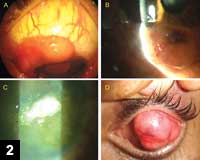 A: Gelatinous OSSN with superficial vessels. B: Papilliform OSSN with a papillary appearance. C: Leukoplakic OSSN with a white keratin plaque covering the lesion. D: Nodular OSSN, generally indicating invasive squamous cell carcinoma. |
Treatment
Treatment for OSSN includes surgery, radiotherapy or topical medications such as mitomycin-C. OSSN without intraocular or orbital invasion requires a non-touch specific technique of excision to prevent recurrence. En toto no-touch, alcohol-assisted epitheliectomy, conjunctivo-tenonectomy and superficial lamellar sclerectomy should be done in these cases.
Before surgery, the limits of the lesion should be determined (Figure 3a). Any additional foci should be carefully looked for. During the entire surgery, it must be remembered to maintain a dry field without balanced salt solution irrigation so as to prevent tumor cell seeding. Absolute alcohol soaked on a sponge is gently applied to the entire corneal component of the OSSN including a 2-mm margin. Alcohol causes epithelial cellular devitalization, allowing the tumor cells to be easily peeled from the Bowman’s layer. A blunt blade is used to microscopically outline the affected epithelium with a 2-mm margin of normal-appearing tissue and then peeled toward the limbus (Figure 3b). The Bowman’s membrane should never at any point be breached. This is left as a scroll resting at the limbus. An incision based at the limbus is then made through the full thickness conjunctiva and Tenon’s fascia 4 mm to 6 mm (Figure 3c) outside the tumor margins to incorporate them into the excised specimen (Figure 3d).
Lamellar dissection of superficial sclera about 0.2 mm in depth and 2 mm outside the base of the overlying adherent conjunctival mass is made (Figure 4a) and continued anteriorly to the limbus (Figure 4b). This superficial lamella of sclera, the previously dissected overlying Tenon’s fascia and conjunctiva with tumor, and the scrolled corneal epithelium are removed en toto (Figure 4c). This entire surgery is done without touching the tumor itself, ie, with a no-touch technique.
Drapes, gloves and all of the instruments used up until now are then replaced with fresh ones for subsequent steps of surgery so as to avoid contamination of healthy tissue with possible tumor cells.
Double freeze-thaw cryotherapy with a rapid freeze and a slow thaw is then applied to the margins of the entire remaining bulbar conjunctiva while lifting it away from the sclera using the cryoprobe. The tumor bed is treated with bipolar cautery followed by absolute alcohol wash on cotton tip applicator. The conjunctiva is then undermined and either directly closed or closed with an amniotic membrane graft (Figure 4d). The removed specimen is placed flat on a paper, topographically labeled so as to identify margins (Figure 5) and submitted for histopathology.
|
|
Images: Jacob S |
Checking margins
If histopathology shows positive margins anywhere, further tissue is resected until all margins are clear.
In case of positive corneal epithelial margins without deep invasion, alcohol-assisted epitheliectomy is done, and the epithelium may be removed as two strips: a strip of immediately adjacent tissue and intermediate tissue. These are sent as two separate specimens. If the intermediate epithelium is found to be free of involvement, the patient may be followed up with or without topical mitomycin-C. If the deep cornea is found to be involved, either clinically or on histopathology, deep lamellar keratectomy is done.
Topical cytotoxic therapy in the form of topical mitomycin, 5-fluorouracil, cidofovir or interferon alpha-2b have been used for OSSN after surgery (Figure 6). They may also be used as primary treatment in non-invasive OSSN. They have also been used before surgery to decrease the size of large carcinomas and to make less invasive or extensive procedures possible. These must be used carefully and only after conjunctival healing to avoid corneal or scleral melts. Brachytherapy and external beam radiotherapy may be used for extensive lesions with poorly defined margins or as palliative therapy for patients not suitable for surgery.
Eyes with intraocular invasion often require a modified enucleation, and those with orbital invasion may require exenteration. Distant metastases are rare and may involve lymph nodes, lungs or bones and may contribute to the mortality.
The incidence of recurrence after incomplete excision is up to 50%, and patients should be kept on careful follow-up postoperatively. Recurrences should be differentiated from post-surgical scarring, pyogenic granuloma, etc. Any recurrence should be aggressively tackled using either surgery or topical chemotherapy. Topical mitomycin-C is given as a 0.04% solution four times a day for 4 weeks, with a 1-week on and a 1-week off period. The patient’s puncta are either plugged with collagen punctual plugs or the patient is advised to practice nasolacrimal duct obstruction while applying the drops to minimize nasal, gastrointestinal and systemic absorption. Skin contact should also be avoided.
Ocular surface squamous neoplasia is a surgical challenge requiring a specialized no-touch technique of surgery. It is important that the surgeon use a minimal manipulation technique for tumor resection to avoid transfer and implantation of tumor cells into previously uninvolved areas.
|
|
|
For more information:
- Soosan Jacob, MS, FRCS, DNB, MNAMS, FERC, Amar Agarwal, MS, FRCS, FRCOPHTH, and Athiya Agarwal, MD, DO, FRSH, can be reached at Dr. Agarwal’s Group of Eye Hospitals, 19 Cathedral Road, Chennai 600 086, India; fax: +91-44-28115871; e-mails: dr_soosanj@hotmail.com or dragarwal@vsnl.com; Web site: www.dragarwal.com.
References:
- Pe’er J. Ocular Surface Squamous Neoplasia. Ophthalmol Clin North Am. 2005;18:1-13.
- Shields CL, Shields JA. Tumors of the conjunctiva and cornea. Surv Ophthalmol. 2004;49:3–24.

